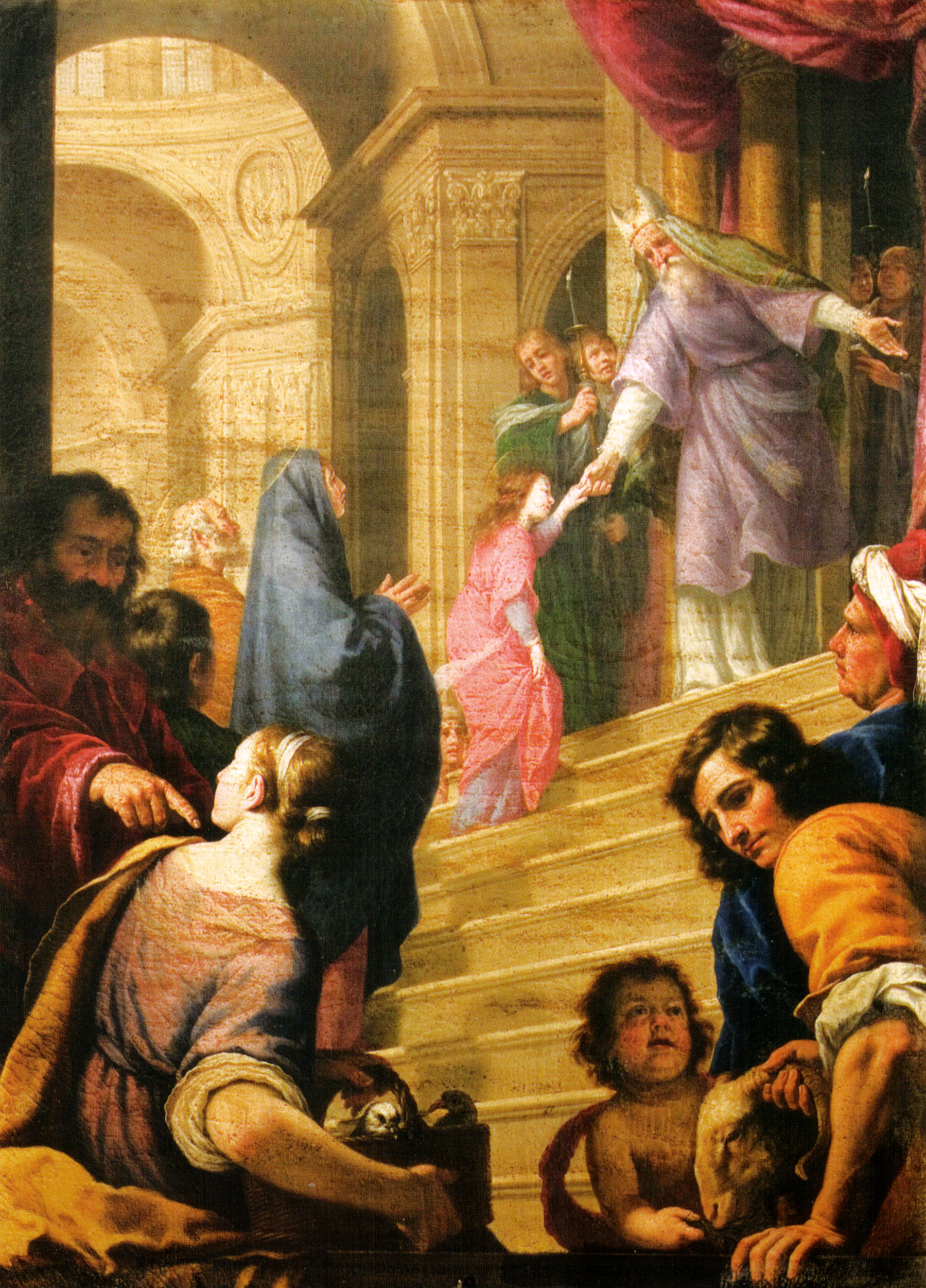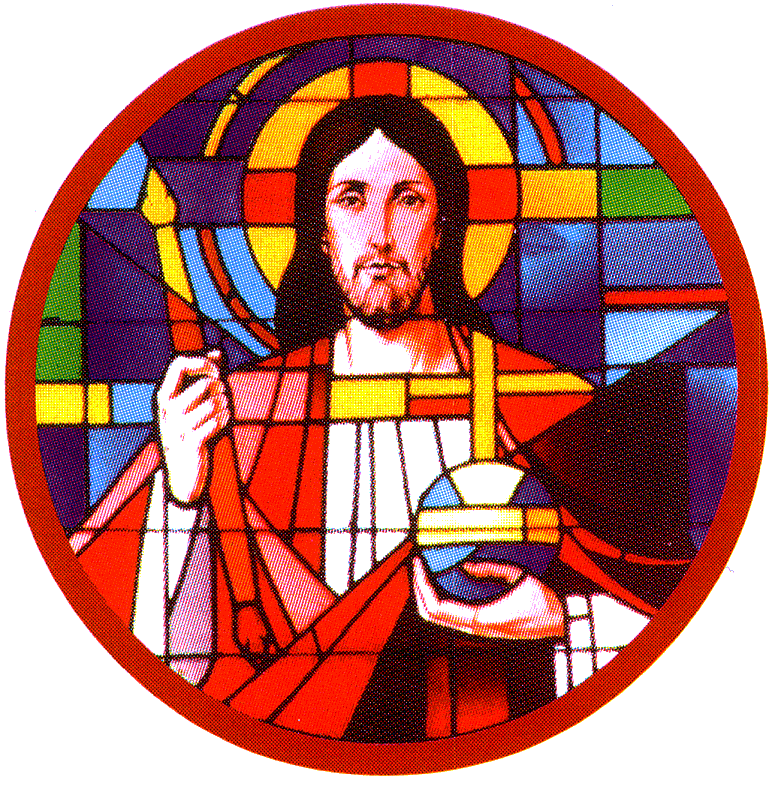 |
| Alfonso Boschi (Florence, 1615-1649), The Presentation of Mary in the Temple |
The Presentation of Mary
Today the Church celebrates the memorial of the Presentation of Mary. The three feasts of the birthday of Our Lady, the Holy Name of Mary and her Presentation in the Temple correspond in the Marian cycle with the first three feasts of the cycle of feasts of our Lord: namely, Christmas, the Holy Name of Jesus, and His Presentation in the Temple (February 2).
"Sacred Scripture contains no text concerning the event commemorated in today's liturgy. For something of a historical background one may consult the apocryphal works, particularly the Protoevangel of St. James (ch. 4:1ff). After an angel had revealed her pregnancy, Anna is said to have vowed her future child Mary to the Lord. Soon after birth the infant was brought to the sacred precincts at which only the best of Israel's daughters were admitted. At the age of three she was transferred to the temple proper (7:2). According to legend, here she was reared like a dove and received her nourishment from the hand of an angel (8:1).
"In the East, where the feast, celebrated since the eighth century, is kept as a public holiday, it bears the name, 'The Entrance of the Mother of God into the Temple'. It was introduced at Rome by a Cypriotic legate to the papal court of Avignon in 1371. In 1472, Sixtus IV extended its observance to the whole Church. Abolished by Pius V, it was reintroduced some years later (1585)." [from Pius Parsch, The Church's Year of Grace]
As we venerate the glorious memory of the most holy Virgin Mary, grant, we pray, O Lord, through her intercession, that we, too, may merit to receive from the fullness of your grace. Through our Lord Jesus Christ, your Son, who lives and reigns with you in the unity of the Holy Spirit, one God, for ever and ever.
* * * * * *
Christ the King (34th Sunday) (Year “B”) - November 25, 2012

“LOOK! JESUS CHRIST COMING WITH THE CLOUDS”
[Daniel 7.13-14 [Psalm 93]; Revelation 1.5-8; John 18.33b-37]
Today brings the current liturgical year to an end. Today's solemnity focuses on Christ the King and, particularly, on his coming in glory at the end of time, the Parousia.
The Book of Daniel is a prophetic writing that sought to interpret events that took place around the time of the Maccabean uprising against King Antiochus IV (about 165 B.C.) In this writing, Daniel witnessed—in revelatory dreams—the conquest by God's people of mighty earthly empires symbolized by a lion, a bear, a leopard and a final beast who was fearsome and utterly devoured its victims, trampling everything underfoot (Daniel 7.1-8).
When all seemed hopeless on earth, Daniel's prophetic dream shifted to the court of heaven, where a mysterious figure, “one like a human being” (literally “one like a son of man”), was seen “coming with the clouds of heaven”. After this figure had approached “the Ancient One” (that is, God), dominion, glory and kingship were given to him so that “all peoples, nations and languages should serve him”.
Apocalyptic literature such as the Book of Daniel was generally written in a code that simultaneously revealed truths to those with insight into the message and concealed its truth from enemies and others who were not to be let in on the communication.
The elasticity of the symbols has allowed Daniel's message to be interpreted as applying to various historical eras. In the New Testament period, Israel's enemy became identified with Rome. During the American Revolution, Christians believed their intended enemy was clearly identified as King George III, while during the French Revolution other Christians just as assuredly understood the enemy of believers to be Louis XIV.
In the gospels, Jesus regularly referred to Himself as “the Son of Man”, a term pointing both to his humanity and his exalted status within God's Kingdom. Indeed, Jesus' usage of this title has been understood as a veiled claim to divine Sonship. And to the role he would exercise at the end of time by ushering in the Final Days and presiding at the Last Judgment. Then as the Son of Man, Jesus Christ would completely defeat the power of sin and death, whose reign have, in principle, been toppled through his paschal mystery.
This is also the point being made by John, the Seer of Patmos, in the reading from Revelation, a key apocalyptic text of the early church. The One to come “with the clouds”—likely to be understood as a sign of divine power—is the same Jesus Christ who had been “pierced” on the Cross, that moment when he “freed us from our sins by his blood”.
Indeed, by his passion, death and resurrection, Jesus has been constituted the “faithful witness, the firstborn of the dead, and the ruler of the kings of the earth”.
In the Fourth Gospel drama that was played out in the Roman procurator's chambers, Jesus seemed anything but regal. But as the encounter between Jesus and Pilate came to its conclusion, Pilate the judge was undergoing judgment by the accused who stood in his presence, Jesus of Nazareth (cf. John 18.28-19.16). By answering Pilate's question (“Are you the King of the Jews?”) with another question (“Do you ask this on your own, or did others tell you about me?”), Jesus turned the tables on Pilate and positioned himself as interrogator.
After showing disdain for Jews, Pilate inquired about Jesus' status and activity (“Are you a king? ... What have you done?”) Jesus described the nature of his kingship (“My kingdom is not from this world”), underscoring the difference between belonging to God's kingship and to one only of this world.
Unlike the realm of Rome that Pilate served, Jesus' kingship was not secured by force. Without directly affirming or denying Pilate's question whether he was a king (“You say that I am a king... for this I came into the world, to testify to the truth”), Jesus went on to describe those who have pledged him allegiance: “Everyone who belongs to the truth listens to my voice”.
No comments:
Post a Comment